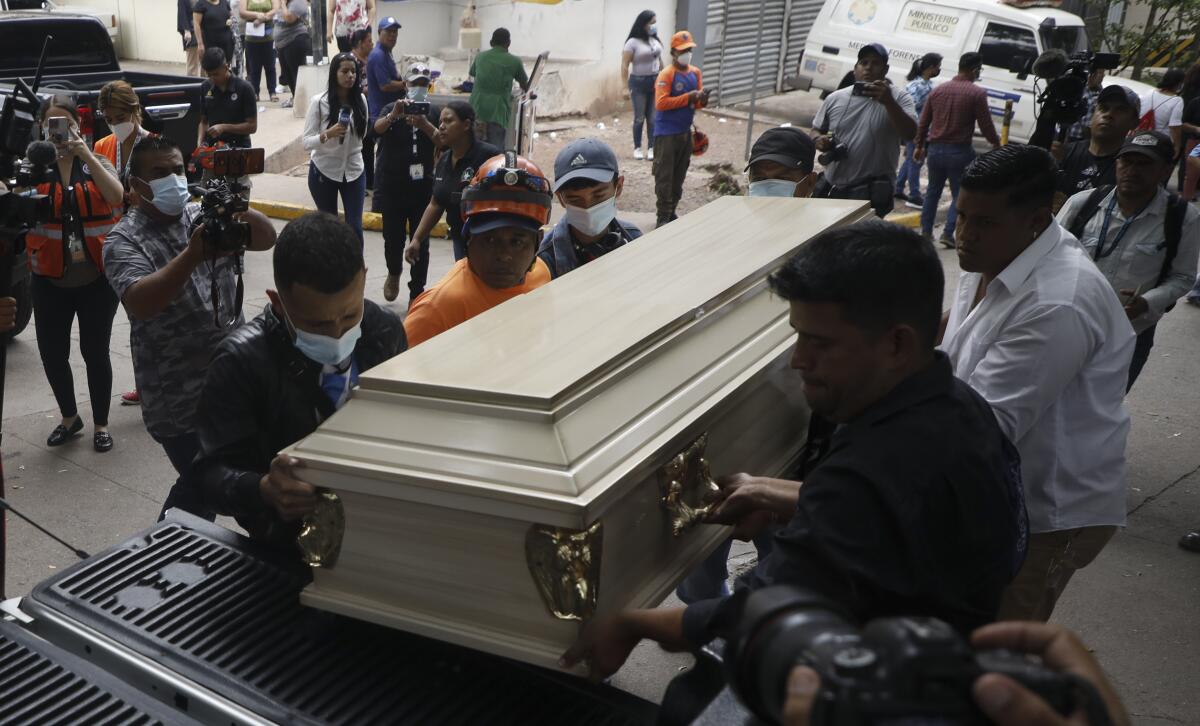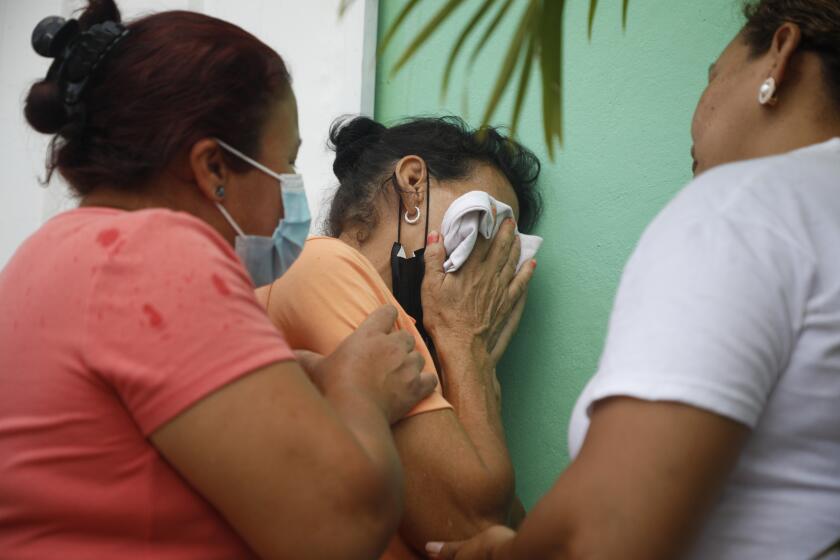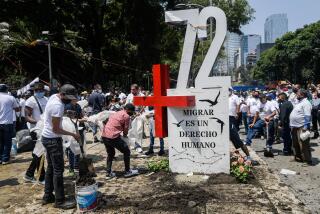Hondurans see little hope for nation’s prisons as details of cold-blooded massacre emerge

- Share via
TEGUCIGALPA, Honduras — Authorities in Honduras began to hand over to relatives the hacked, burned corpses of 46 women killed in the worst riot at a women’s prison in recent memory.
Some of the bodies were so badly burned they need genetic testing or dental studies to identify, said Yuri Mora, the spokesman for Honduras’ national police investigation agency.
The picture that began to emerge of Tuesday’s violence at the women’s prison in Tamara, Honduras, was one of a carefully planned massacre of supposed rival gang members by inmates belonging to the notorious Barrio 18 street gang.
The carnage has led to calls for change to the country’s prison system and even talk of whether Honduras should emulate the drastic zero-tolerance, no-privileges prisons set up in neighboring El Salvador by President Nayib Bukele.
Although El Salvador’s crackdown on gangs has given rise to rights violations, it has also proved immensely popular in a country long terrorized by street gangs.
“One of the grave dangers is the Bukele-ization of the security problem in this country, with everything that would imply,” said Honduran human rights expert Joaquin Mejia.
Inmates had complained for weeks that they were being threatened by gang members at a women’s prison in Honduras, where 41 people were killed Tuesday.
Nobody debates that Honduras’ prisons are in a shameful state. In Tuesday’s riot, incarcerated members of the notorious Barrio 18 gang slaughtered 46 other female inmates by spraying them with gunfire, hacking them with machetes and then locking survivors in their cells and dousing them with flammable liquid.
Chillingly, the gang members were able to arm themselves with pistols and machetes, brush past guards and attack. They even carried locks to shut their victims inside, apparently to burn them to death.
Jessica Sánchez, an activist with the Civil Society Group, a human rights organization, said, “We believe that this massacre was carried out on orders from a criminal network, and I am sure it was known beforehand, and nothing was done.”
Miguel Martínez, a Security Ministry spokesman, said the attack was taped by security cameras up to the moment the gang members destroyed them in what he called a planned attack.
“You can see the moment in which the women overcome the guards, leaving them helpless, and take their keys,” Martínez said.
President Xiomara Castro said the riot at the prison in Tamara northwest of Tegucigalpa was “planned by maras [street gangs] with the knowledge and acquiescence of security authorities.”
At least 41 inmates have been killed in a riot at a women’s prison northwest of the Honduran capital, most of them burned to death.
Castro fired Security Minister Ramón Sabillón, and replaced him with Gustavo Sánchez, who had been serving as head of the National Police.
She ordered that all of the country’s 21 prisons be placed for one year under the control of the military police, who will be asked to train 2,000 new guards.
But she didn’t announce any immediate plan to improve the conditions in prison, which are characterized by overcrowding and crumbling facilities. Security is so lax that inmates often run their cellblocks, selling prohibited goods and extorting money from other inmates.
Many doubted the answer lies in adopting the kind of brutally regimented prisons that El Salvador has built.
“Building more prisons in Honduras isn’t necessary. Why? Why build more prisons that turn into slaughterhouses for people, when the government has no control over them?” said Roberto Cruz, 54, who runs a small retail outlet in the capital.
“What is needed are professional people to run the prisons,” Cruz said, acknowledging that “it is a big, complex problem that needs an urgent solution.”
Most don’t trust the government to get it right.
Daniel Rodriguez of California yells, ‘Trump won!’ as he is led out of the courtroom. Officer Michael Fanone had suffered a heart attack after the stun gun assault.
“We demand an international investigation that can really look at the issue of prisons and women” in prison, said Jessica Sánchez.
For now, the cold facts of Tuesday’s massacre are emerging: Eighteen pistols, an assault rifle, two machine pistols and two grenades were found in the prison after the riot. All were smuggled into the facility.
Then there was the shocking fact that — as in many Latin American jails — some of the inmates’ children were living with their mothers in the prison at the time of the attack.
“Some of the women were living with their children in detention. These children are now left behind and highly vulnerable. I am deeply concerned about their well-being and safety,” said Garry Conille, the regional director for UNICEF, the U.N. children’s fund.
It was not known whether any children witnessed the attack.
The riot’s death toll surpassed that of a fire at a female detention center in Guatemala in 2017, when girls at a shelter for troubled youths set fire to mattresses to protest rapes and other mistreatment. The smoke and fire killed 41 girls.
The worst prison disaster in a century also occurred in Honduras, in 2012, at the Comayagua men’s penitentiary, where 361 male inmates died in a fire possibly caused by a match, cigarette or some other open flame.
More to Read
Sign up for Essential California
The most important California stories and recommendations in your inbox every morning.
You may occasionally receive promotional content from the Los Angeles Times.












